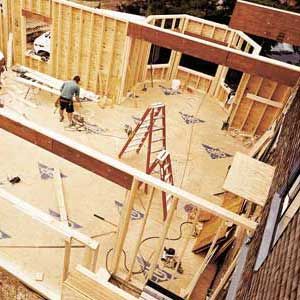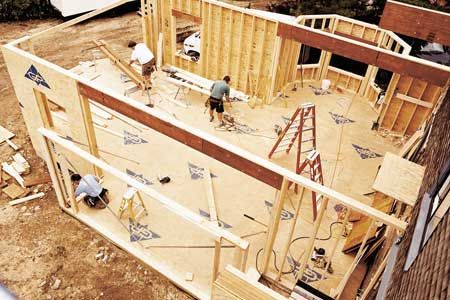
Whether you’re building a new house, renovating or adding on, there are good building practices you should follow if you want the structure to be sound and lasting. Proper framing from the ground up is crucial for ensuring stability and longevity, as it forms the backbone of your entire structure and supports everything else.
What are homeowners looking for? A completed project that they love. All of us want to have the best things. We want our house to look like it came out of one of those glossy magazines, so we buy the things to make this happen: granite countertops, tile or wood floors, fancy crown moldings. Then we go crazy
with lighting and fixtures. Unfortunately, this is a trap a lot of homeowners fall into, sinking money
into things that are visually pleasing instead of making the house as structurally strong as possible.
Framing Floors
When a builder “builds to code,” he adheres to a set of rules that, for example, dictates the length and
spacing of floor joists so that you’ll never have to worry about the floor breaking. But it may have a little bounce to it. When the kids are running through the kitchen the plates in the cupboard may rattle a little; when they’re playing upstairs the light fixtures in the dining room ceiling may swing a bit.
These and many other problems can be avoided by a few simple changes, and that is why my crew always goes beyond the building code. If the code calls for 2×10 floor joists, we go to 2×12. Even better, instead of framing 24 inches on center, we drop the spacing between each joist, making it 19.2 or even 16 inches on center. We don’t stop with the floors. How we cover the structure and the products we use make a huge difference. For subflooring, it’s 3/4-inch tongue-and-groove plywood glued and nailed to the structure. When applying the construction adhesive, we never use more then can be covered in a matter of minutes. Applied too far ahead of the plywood, the adhesive will form a skin; when the plywood is laid on the joists it will not adhere. Result: The floor will start to squeak in a few years. Worse than that, the system is not as strong as it should be.
Bridging—those little X-shaped pieces of wood between the joists that everyone thinks are there to keep the joists from tipping over—is really there to distribute across the joist system the load put
on the floor. Every 9-foot 1-inch span or greater should have wood or metal bridging, and it has to fit nice and tight. When using conventional lumber, wood bridges can be installed right away; with the metal, we nail the top to the joists but wait until we’re ready to install the finished ceiling before nailing the bottoms. This way, the joists get to dry out first, because if the joists shrink, the metal bridging will loosen. This is not a consideration, by the way, when using engineered I-joists. They can be bridged immediately.
Framing Walls
On the walls, we always frame 16 inches on center, which makes them stiffer and stronger. How the corners are put together—both inside and out—is very important. A minimum of three studs are needed
to make up both inside and outside corners. Any hard-to-reach pockets we create while framing we insulate then and there, preventing hot and cold spots and the moisture that will form in such spaces if they’re not insulated correctly. Avoiding that moisture means avoiding mold, mildew, rot, peeling paint and insects. Carpenter ants love wet places.
We use 16-penny nails when nailing into the end grain on the top and bottom of the wall and into headers, 10-penny or toed 16-penny nails when making up jack studs and headers. And we’re not stingy with the nails—we use plenty. Walls over eight feet tall require a row of horizontal blocking. We use diagonal braces in corners or glue the sheathing to the studs on all outside corners. I think the building code is light on the side sheathing thickness, so we never go any less than 1/2 inch. We leave an 8-penny-nail’s-width spacing on all four edges of our wall sheathing, which allows it to expand and contract without buckling. When going from one level of floor to the next, we make sure the sheathing spans the rim or band joist. We never install a strip there—it would be useless. If need be, we start with a narrower strip on the first floor.
Framing the Roof
When stick-framing the roof structure, we build 16 inches on center. For trusses, I like 16 or 19.2 inches on center. We use hurricane clips nailed to every rafter to tie the plate and rafter together, along with toed 12- or 16-penny nails. We prefer laminated veneer lumber—LVLs—for ridges, valleys and hips when long spans are called for. Roof sheathing, like floor and side walls, gets a space between both the short and long edges. For roof sheathing, we always exceed the code—5/8-inch is the thinnest I will go. Gluing the first row to the roof structure in high wind areas doesn’t hurt either.
We nail all the sheathing—floors, walls and roofing—eight inches on center, making sure the nail goes into the center of the framing. When nailing with an air-powered gun, we make very sure that the nail head sits flush with the surface. The deeper the nails go in, the thinner the sheet is that the nails are holding, and the easier the sheathing will come off or break free as the wood expands and contracts.
These are a few of the most important steps in building a better structure. This is where your money
should go first. If your home is strong and stiff, all the finishes you’ll be spending good money on will last longer and work better. The floor won’t squeak or bounce, the walls and ceiling won’t crack. The doors will swing and close smoothly. The kitchen cabinets and countertops will stay in position after they are set. And if the extra money you spend on getting the structure right makes it impossible to afford those fancy crown moldings or stone countertops or the wood and tile floors, you can always add them later. As long as your house is strong and sound, it’ll be worth the wait.

